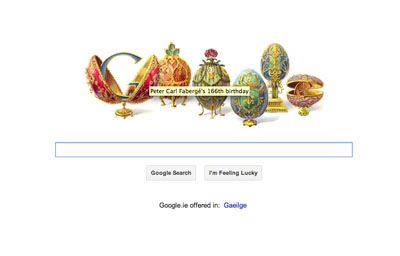Peter Carl Fabergé at work. Image from Wikimedia Commons
There’s a distinctively Easter feel to the Google Doodle today, which celebrates the 166th anniversary of the birth of jeweller and goldsmith Peter Carl Fabergé, who is eponymous for his Fabergé eggs that were stylised in fine grandeur using precious metals and gemstones.
Fabergé himself was born on this day in 1846 in Saint Petersburg, Russia. His father was a jeweller by the name of Gustav Fabergé, who had a jewellery workshop, while his mother was Charlotte Jungstedt.
In 1860, the Fabergé family retired to Dresden, leaving the workshop in the hands of family and friends. It is thought that Peter Carl may have taken a course at the Dresden Arts and Crafts School.
In 1864, he went on a tour of Europe and received tuition from goldsmiths in Germany, France and England.
At the age of 26, Peter Carl returned to St Petersburg and married Augusta Julia Jacobs. He was then mentored by one of his father’s employees, Hiskias Pendin, at his father’s jewellery workshop.

Today’s Google Doodle, a stylised Google logo on Google’s homepage, reveres the craftsmanship of Peter Carl Fabergé, renowned for his distinctive Fabergé egg creations. Apparently, the preparation of each of the Fabergé eggs took about a year. It’s believed a Fabergé egg, dubbed the ‘Rothschild Egg’ sold for stg£8.9m at Christie’s in 2007
When Pendin died in 1882, Fabergé then took over the running of the company. He got the title of master goldsmith so he could use his own hallmark on his jewellery.
Fabergé’s brother Agathon joined the company as a creative designer and the duo made their mark at the Pan-Russian Exhibition in 1882, especially for their copies of ancient Russian treasures.
In 1885, Tsar Alexander III gave the House of Fabergé the title of official goldsmith to the Imperial Crown.
The tsar commissioned the company to make an Easter egg for his wife, the Empress Maria. And from then on a new tradition was that Fabergé created at least one of his eggs each year. There are 65 known large Fabergé eggs.
As well as its egg creations, the Fabergé company also made silver tableware and fine jewellery.
In 1916, the House of Fabergé became a joint-stock company. However, with the outbreak of the October Revolution in Russia, the business was taken over and in 1918, the Bolsheviks nationalised the House of Fabergé.
Fabergé left St Petersburg and first fled to Germany before relocating to Switzerland.
He died in Switzerland on 24 September 1920.